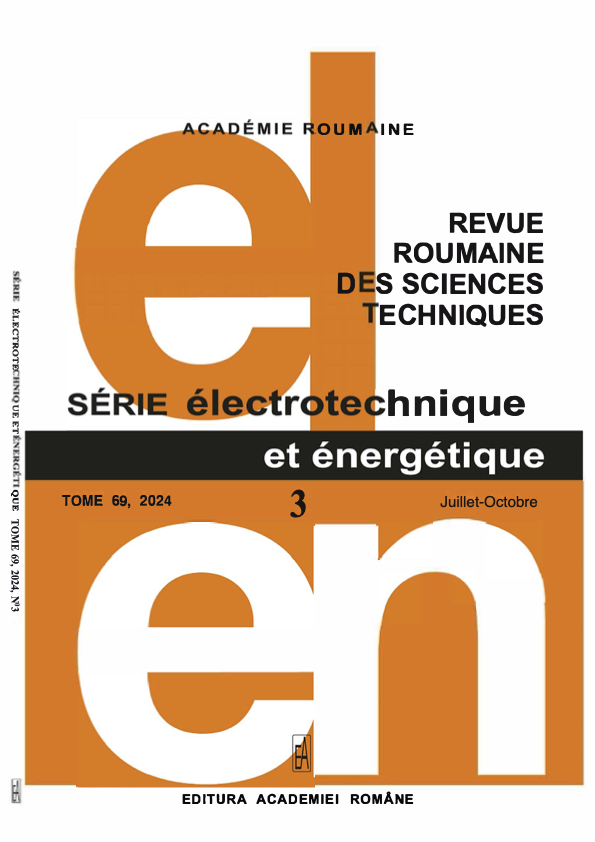SIMULATION OF BIOMASS CARBONIZATION AND HEAT RECOVERY FOR ELECTRICITY PRODUCTION USING SEEBECK MODULES
DOI:
https://doi.org/10.59277/RRST-EE.2024.69.3.17Keywords:
Pyrolysis, Wood biomass, Seebeck effect, Finite element method (FEM), Numerical simulationAbstract
This paper experimentally and numerically examines biomass carbonization and using thermoelectric modules to recover heat and generate electricity using the finite element method (FEM). Carbonization, conducted at high temperatures, produces charcoal and gases. The study identifies optimal temperatures for module placement, demonstrating that they can generate up to 6.5 W of electricity. Moreover, integrating the chimney to optimize the carbonization process produced hot air with a maximum gain of 11 °C above the ambient temperature. This approach enhances energy efficiency and reduces costs
References
(1) A.M. Omer, Sustainable development and environmentally friendly energy systems in Sudan, Adv. Environ. Res., 36, 1, pp. 51–94 (2014).
(2) Y. Zhang, Y. Ji, H. Qian, Progress in thermodynamic simulation and system optimization of pyrolysis and gasification of biomass, Green Chem. Eng., 2, 3, pp. 266–283 (2021).
(3) D. Champier, J. Bédécarrats, T. Kousksou, M. Rivaletto, F. Strub, P. Pignolet, Study of a TE (thermoelectric) generator incorporated in a multifunction wood stove, Energy, 36, 3, pp. 1518–1526 (2011).
(4) A. Radenović, Pyrolysis of coal, Kem. u Ind. Chem. Eng., 55, 7, pp. 311–319 (2006).
(5) W.C. Park, A. Atreya, H.R. Baum, Experimental and theoretical investigation of heat and mass transfer processes during wood pyrolysis, Combust. Flame, 157, 3, pp. 481–494 (2010).
(6) A. Kulkarni, G. Mishra, S. Palla, P. Ramesh, D. Surya, T. Basak, Advances in computational fluid dynamics modeling for biomass pyrolysis: a review, Energies, 16, 23, pp. 1–32 (2023).
(7) J.P. Abraham, E.M. Sparrow, J.C.K. Tong, Heat transfer in all pipe flow regimes: laminar, transitional/intermittent, and turbulent, Int. J. Heat Mass Transf., 52, 3, pp. 557–563, (2009).
(8) D.D. Gray, A. Giorgini, The validity of the Boussinesq approximation for liquids and gases, Int. J. Heat Mass Transf., 19, 5, pp. 545–551 (1976).
(9) M.G. Gronli, M.C. Melaaen, Mathematical model for wood pyrolysis-comparison of experimental measurements with model predictions, Energy and Fuels, 14, 4, pp. 791–800 (2000).
(10) B. Geppert, D. Groeneveld, V. Loboda, A. Korotkov, A. Feldhoff, Finite-elements simulations of a thermoelectric generator and their experimental validation, Energy Harvest. Syst., 2, 1, pp. 95–104 (2015).
(11) Y. Köysal, Performance analysis on solar concentrating thermoelectric generator coupled with heat sink, Int. J. Precis. Eng. Manuf., 20, 2, pp. 313–318 (2019).
(12) A. Morega, M. Morega, A FEM model of thermoelectric and thermomagnetic effects, Rev. Roum. Sci. Techn. – Électrotechn. Et Énerg., 48, 1, pp. 2 (2003).
(13) D. Mani, P. Kpelou, N. Attah, S. Kombate, Energy resource of charcoals derived from some tropical fruits nuts shells, Int. Journal of Renewable Energy Development, 9, 1, pp. 29–35 (2020).
(14) A. Demirbas, Effect of initial moisture content on the yields of oily products from pyrolysis of biomass, J. Anal. Appl. Pyrolysis, 71, 1, pp. 803–815 (2004).
(15) G.Qi, Z. Wang, S. Zhang, Y. Dong, J. Guan, P. Dong, Numerical simulation on biomass-pyrolysis and thermal cracking of condensable volatile component, Int. J. Hydrogen Energy, 45, 22, pp. 12283–12297 (2020).
(16) J. Prapas, M. Baumgardner, A. Marchese, B. Willson M. DeFoort, Influence of chimneys on combustion characteristics of buoyantly driven biomass stoves, Energy Sustain. Dev., 23, 1, pp. 286–293 (2014).
(17) R. Hall, An analysis of the performance of thermoelectric devices made from long-lifetime semiconductors, Solid State Electron., 2, 3, pp. 115–122 (1961).
(18) H.C. Kung, A mathematical model of wood pyrolysis, Combust. Flame, 18, 2, pp. 185–195 (1972).
(19) F.X. Collard, J. Blin, A review on pyrolysis of biomass constituents: Mechanisms and composition of the products obtained from the conversion of cellulose, hemicelluloses, and lignin, Renew. Sustain. Energy Rev., 38, 1, pp. 594–608 (2014).
(20) K. Sornek, M. Filipowicz, A study of the applicability of a straw-fired batch boiler as a heat source for a small-scale cogeneration unit, Chemical and Process Engineering., 37, 4, pp. 503–515 (2016).
(21) *** Comsol Multiphisics, v.6.2.
Downloads
Published
Issue
Section
License
Copyright (c) 2024 REVUE ROUMAINE DES SCIENCES TECHNIQUES — SÉRIE ÉLECTROTECHNIQUE ET ÉNERGÉTIQUE

This work is licensed under a Creative Commons Attribution-NonCommercial-NoDerivatives 4.0 International License.


